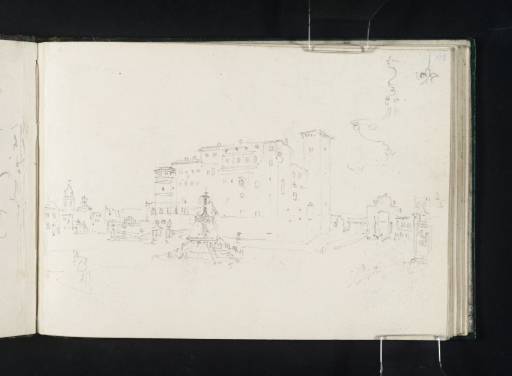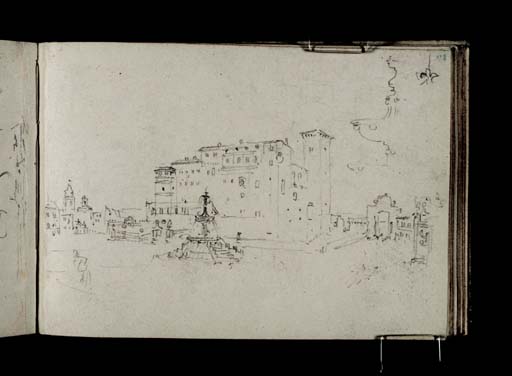Joseph Mallord William Turner The Piazza della Rocca, the Porta Fiorentina and a Fountain, Viterbo 1828
Image 1 of 2
Joseph Mallord William Turner,
The Piazza della Rocca, the Porta Fiorentina and a Fountain, Viterbo
1828
Folio 40 Verso:
The Piazza della Rocca, the Porta Fiorentina and a Fountain, Viterbo 1828
D21835
Turner Bequest CCXXXVI 40a
Turner Bequest CCXXXVI 40a
Pencil on white wove paper, 125 x 171 mm
Accepted by the nation as part of the Turner Bequest 1856
References
1909
A.J. Finberg, A Complete Inventory of the Drawings of the Turner Bequest, London 1909, vol.II, p.724, CCXXXVI 40a, as ‘Piazza, with fountain’.
1984
Cecilia Powell, ‘Turner on Classic Ground: His Visits to Central and Southern Italy and Related Paintings and Drawings’, unpublished Ph.D thesis, Courtauld Institute of Art, University of London 1984, pp.300 note 12, 438.
1987
Cecilia Powell, Turner in the South: Rome, Naples, Florence, New Haven and London 1987, pp.[138], 206 note 10.
This is one of five consecutive pages in the present sketchbook depicting the city of Viterbo: see also folios 40 recto and 41 recto–42 recto (D21834, D21836–D21838). As identified by Cecilia Powell, Turner composed this view from the corner of the Piazza della Rocca, in the northern part of Viterbo.1 Looking north-west, he placed at the centre of the composition the square’s ornate fountain.
A fountain known as San Pietro alla Rocca has existed on the site since the Middle Ages.2 In the late sixteenth century, under Cardinal Alessandro Farnese, it was replaced with a new structure designed by the architect Giacomo Barozzi da Vignola.3 Vignola was also among the architects to design the Palazzo Farnese in Caprarola, a subject Turner sketched extensively: for a fuller commentary and list of works, see under folio 4 verso (D21772). The fountain’s elaborate design, consisting of stepped sides and several octagonal and circular basins, is outlined here by the artist. An enlarged profile is outlined in the top-right corner, and the fleur-de-lys finial is reproduced above as a separate detail. This study is inverted relative to the sketchbook’s foliation.
Beyond the fountain, the large building overlooking the square was constructed in 1354 by Cardinal de Albornoz.4 Initially conceived as a fortress, it was transformed into a Renaissance palace under Pope Julius II in the early 1500s. A loggia was later added under Pope Paul III. Historically, the building has functioned variously as a papal residence, orphanage and barracks. Since 1986, it has housed the city’s archaeological museum dedicated to Etruscan artefacts, the Museo Nazionale Etrusco di Rocca Albornoz.5
To the right is an outline of the Porta Fiorentina, or ‘Florentine’ gateway, built in 1768 under Pope Clement XIII.6 The gateway is surmounted with his coat of arms, as roughly indicated here by Turner.
Hannah Kaspar
December 2024
‘Fontana di Piazza della Rocca’, Viterbo, accessed 16 July 2024, https://viterbo.artecitta.it/fontana-di-piazza-della-rocca/ .
‘Museo Nazionale Etrusco di Rocca Albornoz’, Direzione Regionale Musei Lazio, accessed 16 July 2024, https://direzioneregionalemuseilazio.cultura.gov.it/en/luoghi/museo-nazionale-etrusco-rocca-albornoz/ .
‘Porta Fiorentina’, Viterbo, accessed 16 July 2024, https://viterbo.artecitta.it/porta-fiorentina/ .
How to cite
Hannah Kaspar, ‘The Piazza della Rocca, the Porta Fiorentina and a Fountain, Viterbo 1828’, catalogue entry, December 2024, in David Blayney Brown (ed.), J.M.W. Turner: Sketchbooks, Drawings and Watercolours, Tate Research Publication, February 2025, https://www


